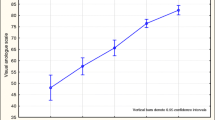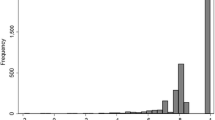Abstract
Purpose
The aim of the study was to investigate and identify aspects of health-related quality of life (HRQoL) that are most valued by IsiXhosa-speaking people resident in underresourced areas of Cape Town, South Africa.
Methodology
Fifty-seven domains of HRQoL were identified as important through group discussions with IsiXhosa-speaking people. Participants randomly selected from the community (n = 601) and from individuals seeking medical attention at a local clinic (n = 102) graded the domains on a visual analogue scale (VAS) ranging from 0 for “not at all important” to 10 for “ very important”. The domains were then mapped to the categories of the International Classification of Functioning, Disability and Health.
Results
The domains regarded as being most important were Food availability [9.5, standard deviation (SD) = 1.52), Owning a brick house (9.4, SD = 1.57), Access to medical services (9.4, SD = 1.55) and Family safety (9.4, SD = 1.7). Having no bodily pain ranked 40th. Environmental Factors were valued significantly more than the other two categories, and those related to Body Functions were valued higher than domains in the category of Activity and Participation.
Discussion and conclusion
Despite being asked specifically to answer the questions in relation to their health status, the participants apparently did not differentiate between general quality of life (QoL) and specific HRQoL. It appears that members of an underresourced community regard socioeconomic and service delivery aspects of their lives as integral to their perceived state of health. It may be that it is not possible to separate out factors relating to general QoL from those specifically related to HRQoL in an underresourced population, and such populations might not be suitable for inclusion in certain clinical trials where an improvement in HRQoL is the required outcome. Alternatively, if an HRQoL instrument is to be used to monitor the impact of medical interventions, the inclusion of Environmental Factors should be considered.
Similar content being viewed by others
References
Mkoka, S., Jelsma, J., & Vaughan, J. (2003). The pitfalls of translation. South African Medical Journal, 93, 265–266.
Jelsma, J., Amosun, D., Mkoka, S., & Nieuwveld, J. (2004). The reliability and validity of the Xhosa version of the EQ-5D. Disability and Rehabilitation, 26, 103–108.
Jelsma, J., De Weerdt, W., De Cock, P., Mielke, J., & Mhundwa, K. (2002). The validity of the Shona Version of the EQ-5D quality of life measure. South African Journal of Physiotherapy, 58, 8–12.
O’Keefe, E. A., & Wood, R. (1996). The impact of human immunodeficiency virus infection on quality of life in a multiracial South African population. Quality of Life Research, 5, 275–280.
World Health Organization. (2001). International Classification of Functioning, Disability and Health—short version. Geneva: World Health Organization.
Rosenbaum, P., & Stewart, D. (2004). The World Health Organization international classification of functioning, disability, and health: A model to guide clinical thinking, practice and research in the field of cerebral palsy. Seminars in Pediatric Neurology, 11, 5–10.
City of Cape Town. (2005). Demographics. http://www.capetown.gov.za/home/demographics.asp (July 2005).
City of Cape Town. (2006). City of Cape Town—census 2001–2006 suburbs. Cape Town. http://www.capetown.gov.za/censusinfo/Census2001-new/Suburbs/Khayelitsha.htm (17 October, 2007).
Médecins Sans Frontières and Infectious Disease Epidemiology Unit University of Cape Town. (2003). Providing HIV services including antiretroviral therapy at primary health care clinics in resource-poor settings: The experience from Khayelitsha. Cape Town. http://www.msf.org/source/countries/africa/southafrica/2004/1000/khayelitsha1000.pdf (17 October, 2007).
Jelsma, J., MacLean, E., Hughes, J., Tinise, X., & Darder, M. (2004). An investigation into the health related quality of life of individuals living with HIV who are receiving Highly Active Anti-retroviral Therapy (HAART). AIDS Care, 17, 579–588.
Jelsma, J., Maart, S., Eide, A., Ka’toni, M., & Loeb, M. (2007). The determinants of health-related quality of life in urban and rural IsiXhosa-speaking people with disabilities. International Journal of Rehabilitation Research, 30, 119–126.
Lamers, L., McDonnell, J., Stalmeier, P., Krabbe, P., & Busschbach, J. (2006). The Dutch tariffs: Results and arguments for a cost-effective design for national EQ-5D valuation studies. Health Economics, 15, 1121–1131.
Wilson, K. L., & Lizzio, A. (1997). The development, validation and application of the course experience questionnaire. Studies in Higher Education, 22, 33–53.
Feeny, D. H., & Torrance, G. W. (1989). Incorporating utility-based quality-of-life assessment measures in clinical trials. Two examples. Medical Care, 27, S190–S204.
Brooks, R., & EuroQol Group. (1996). EuroQol: The current state of play. Health Policy, 37, 53–72.
World Health Organization. (2001). International Classification of Functioning, Disability and Health—browser version. Geneva: World Health Organization.
Stat Soft. (2004). Statistica.
Cohen, J. (1988). Statistical power analysis for the behavioral sciences. Hillsdale, NJ: Lawrence Earlbaum.
Atijosan, O., Kuper, H., Rischewski, D., Simms, V., & Lavy, C. (2007). Musculoskeletal impairment survey in Rwanda: Design of survey tool, survey methodology, and results of the pilot study (a cross-sectional survey). BMC Musculoskeletal Disorders, 8, 30.
Jelsma, J., Mielke, J., Powell, G., Fox, B., Weerdt, W. D., & Cock, P. D. (2002). Disability in an urban black community in Zimbabwe. Disability and Rehabilitation, 24, 851–859.
Statistics South Africa. (2005). Data census 2001: Primary tables Western Cape: Census 1996 and 2001 compared. In Statistics South Africa, 2005, Government of South Africa, Pretoria.
Furlong, W. J., Feeny, D. H., Torrance, G. W., & Barr, R. D. (2001). Health Utilities Index (HUI) system for assessing health-related quality of life in clinical studies. Annals of Medicine, 33, 375–384.
Essink-Bot, M., Krabbe, P., Bonsel, G., & Aaronson, N. (1997). An empirical comparison of four generic health status measures. Medical Care, 35, 522–537.
Jelsma, J., Chivaura, V., De Cock, P., & De Weerdt, W. (2000). A bridge between cultures: A report on the process of translating the EQ-5D instrument into Shona. South African Journal of Physiotherapy, 56, 3–9.
Paul, D. (1999). Biological and biopsychosocial models of health and disease in dentistry. Journal of Canadian Dental Association, 65, 496–497.
Acknowledgements
We thank S. Mgqwaki, N. Ndongeni and K. Sisusa for assistance in data collection, Prof. D. McIntyre for advice and the Medical Research Council of South Africa and the University of Cape Town for providing funding.
Author information
Authors and Affiliations
Corresponding author
Rights and permissions
About this article
Cite this article
Jelsma, J., Mkoka, S. & Amosun, S.L. Health-related quality of life (HRQoL) domains most valued by urban IsiXhosa-speaking people. Qual Life Res 17, 347–355 (2008). https://doi.org/10.1007/s11136-007-9304-3
Received:
Accepted:
Published:
Issue Date:
DOI: https://doi.org/10.1007/s11136-007-9304-3




